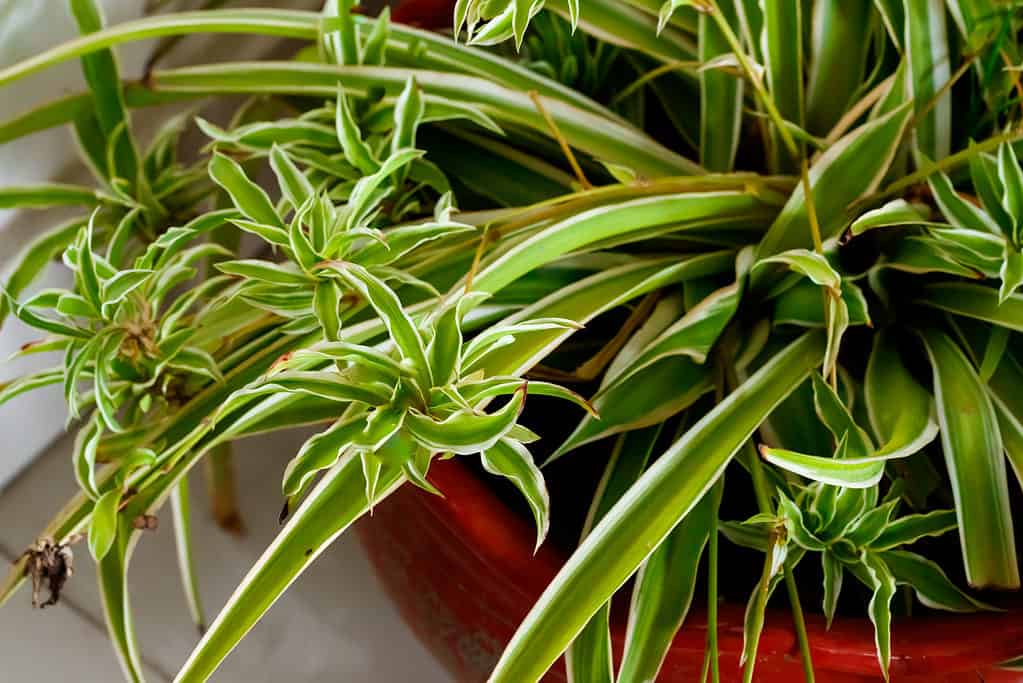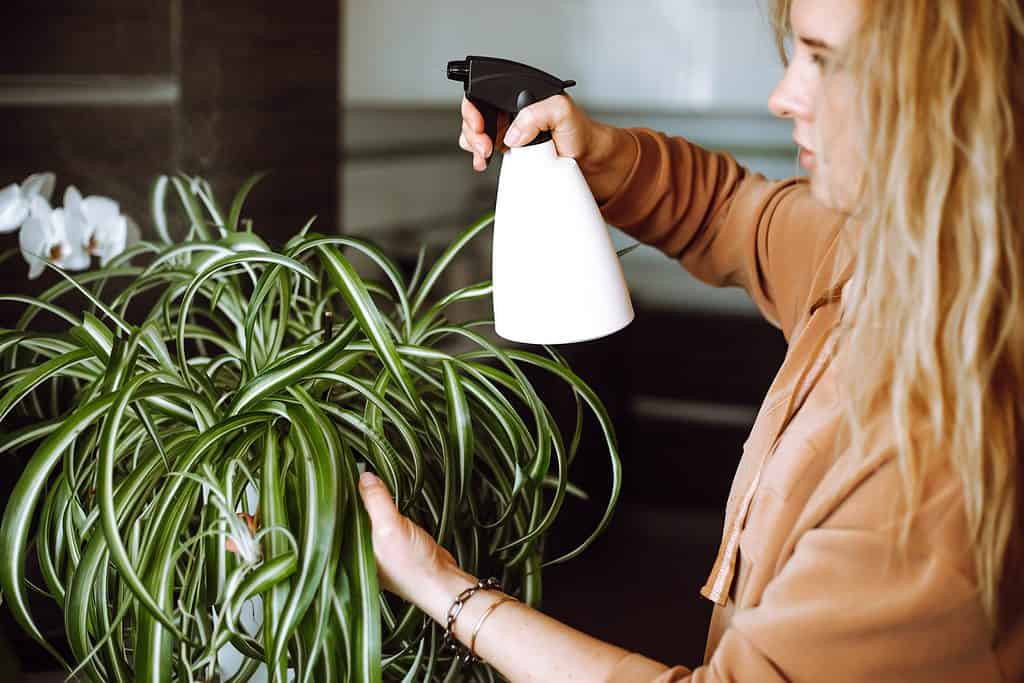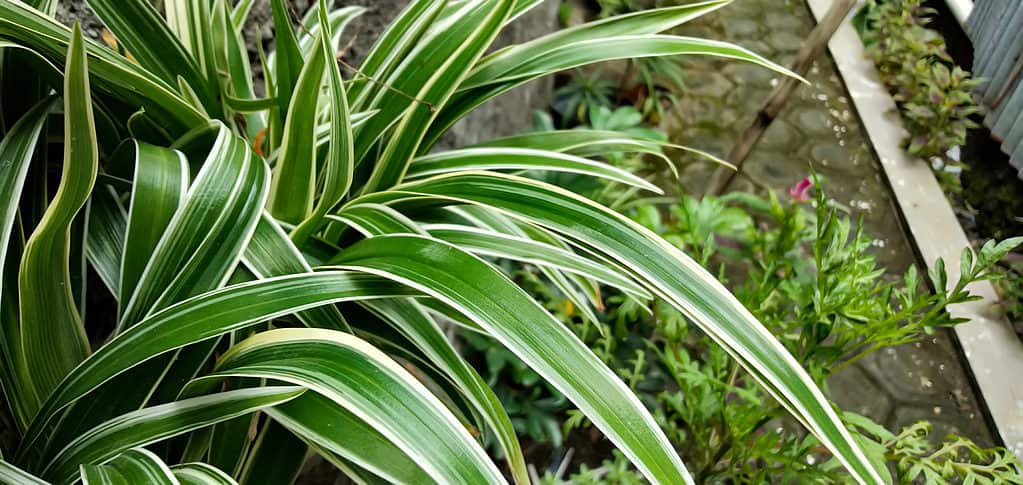If given the proper care, spider plants are common, low-maintenance houseplants that last for many years. The temperature, the plant’s location, and the kind of soil you use will all have an impact on how frequently you need to water your spider plant. Generally speaking, watering your spider plant once per week is ideal. Before watering, check to see how dry the dirt is in the pot; if it doesn’t feel parched, then don’t water it.
In order to keep your plants healthy and growing for many years, we’ll go over all you need to know about watering spider plants in this guide.
How to Water Your Spider Plant
Spider plants are a great choice for anybody wishing to start gardening as a pastime or even if you simply want some greenery indoors because they are so simple to cultivate.
So how much water does a spider plant need and how frequently should a spider plant be watered? The amount of water that is needed depends on location, soil type, time of year, and development stage, hence there are no definitive solutions to these issues.
In general, depending on how warm it is and whether they are exposed to direct sunlight, it is advised to water spider plants once or twice a week. Check the soil with your finger to determine if the top layer has dried off before watering. Continue to wait a day or two before watering the soil if it is still sufficiently damp. A soil moisture meter can also help you determine when the soil needs to be watered once again.
In order to create a watering schedule if you’re new to caring for spider plants, it’s a good idea to keep note of when you’ve watered by recording the date on a calendar or on your phone.
Just as well, ensure that you are using room temperature, filtered, chlorine-free water to water or mist your spider plant. You can simply use a water filter or purchase a chlorine remover product to put into the water you plan on using to water your plants. Because spider plants are sensitive to chlorine and other pollutants added to tap water, it is better to use rainwater or filtered water for them. If all you have is tap water, leave it in the watering can overnight to allow the chemicals in your tap water to disperse.
Occasionally spraying or misting spider plants will be beneficial, especially in hot, dry conditions. To assist raise humidity in the summer, mist the leaves every few days. The optimum time to sprinkle indoor plants is early in the day so that the water has time to evaporate before dusk.

A potted spider plant (pictured) will begin to develop brown tips if it is not watered enough.
©iStock.com/niuniu
Can Spider Plants Survive Without Water?
In warm weather, spider plants may go up to two weeks without water, but in chilly weather, they can go up to three weeks. It’s a good idea to hire someone to water your plants at least once a week if you’re planning a lengthy trip to prevent the plants from becoming stressed.
Should I Water My Spider Plant Daily?
Absolutely not! From spring to fall, water your plants once a week. However, trim this back in the winter as research suggests that this plant may thrive in months with little sunshine and live for up to 15 days without water. Consider the indoor environment you share with your spider plant. Is the temperature a bit warm? Humans drink more during periods of high heat and indoor plants also require more water. However, you will start to see brown lines on the leaves if you water too much, especially in colder winters.
Instead of enormous quantities of water, spider plants require at least eight and sometimes up to ten hours of indirect sunshine each day to remain healthy. Verify that the soil is not soaking wet. If it is, wait a few days before checking once more. When we’re talking about spider plants, less is more when it comes to watering.
Symptoms of Overwatering and Underwatering
Overwatering is evident when your spider plant’s leaves develop brown or sandy color areas, which commonly happens in the winter. A healthy spider plant often sports spiky, arched green leaves with vivid white stripes. The first thing to do is to stop watering so regularly if you observe streaking, browning at the tips, or mottling on the leaves. Check to see whether your plant’s look has improved a few days later.
Your spider plant losing its vibrant vigor or appearing to wilt or flip over in the pot is another indication that you’ve overwatered it. Use a drip tray or saucer to catch the extra water after watering to prevent it from collecting in the pot. So that the spider plant roots are not resting in soggy wet circumstances, empty this tray 30 minutes after watering your plant.
Another serious issue for spider plants is underwatering. Make sure the plant doesn’t go for days without water before letting the soil dry up. Your spider plant’s leaves will begin to become a lighter shade if it doesn’t receive enough water. When your plant doesn’t get enough water, the leaves will lighten from their normal deep green color. This makes it very simple to determine whether your plant needs water.
Another sign of underwatering is when your spider plant’s leaves begin to curl up along their length. It’s time to water your plant once again when you see this. Whether you’ve just watered your plant, wait a couple more days for the soil to dry up before checking to see if your plant is starting to unfurl its leaves once more. Waiting an extra day is preferable to overwatering your plant.

You can water your spider plant (pictured) in a number of ways in addition to leaf misting for optimal plant health.
©tativophotos/Shutterstock.com
Different Ways to Water Your Spider Plant
There are three different ways you can water your spider plant. You can water it over the soil, from the bottom, or via a water bath.
The most typical way to water spider plants is by watering over the soil. Using a watering can or placing the plant directly under a faucet, provide water to the soil. Water should be added to the pot until it begins to drain from the drainage holes. When watering a plant with a tray underneath, be careful to empty the tray completely afterward. Keep your plant out of standing water at all times. Make sure the water is no longer dripping from the bottom of the tap after watering the plants.
Another well-liked technique for watering spider plants is bottom watering. Fill a tray with water and place your plant directly into the water with its drainage holes exposed to the water. Ten minutes after waiting, check to see if the soil has absorbed enough water by feeling it from the top of the pot. If the soil has been wet all the way through, empty the tray of any extra water. More water should be added to the tray if it’s still dry. Prior to eliminating the excess, wait another 20 minutes just to be sure the soil has absorbed as much water as it needs.
Water baths are also simple to do. Put warm water in a bucket or other container. Stop where the plant’s stem begins and lower the entire container into the water. Be sure the soil is completely submerged in water. Wait until the water stops bubbling before continuing. Let the excess drain out by raising the pot. Place your potted spider plant back onto its cachepot. After a few minutes, check to see if the cachepot or tray has a lot of excess water in it. If so, toss it to avoid having excess water in your pot.

A spider plant (pictured) will thrive with the right amount of regular waterings.
©Rezky Bagus Pambudiarso/Shutterstock.com
Tips for Watering Your Spider Plant
A healthy spider plant depends on its soil, and if the soil has too much salt, the plant will not be happy. So, when you water, consider prevention: Is my soil wet and full of nutrients? Before each watering, thoroughly inspect the soil.
Repotting your spider plant every two years and using new soil will also be beneficial. By doing this, several issues are avoided, including dark leaves brought on by inadequate feeding, salt buildup in the pot, or even excessive fluoride in your water.
If a spider plant begins to pull out of its current soil, you know it needs fresh soil. Give it fresh, new compost every couple of years to watch it flourish. Think of it as giving your spider plant a fresh, new makeup every couple of years to encourage growth.
When feasible, try to hydrate spider plants using rainfall or filtered water. Chlorine and fluoride in water can cause the tips of spider plants’ leaves to become brown, and they are extremely sensitive to these chemicals. While sometimes watering a spider plant with tap water won’t do any serious harm, it’s recommended to use rainwater or filtered water to keep it healthy.
Regularly mist your spider plants. Native to regions with moderate humidity, spider plants. At least once a week, mist your spider plant’s leaves with water to simulate the humidity of its natural habitat. If you live somewhere in an extremely dry environment, spray more often. Due to low humidity, the tips of the leaves are showing signs of stress by turning brown.
A spider plant can dry out too soon if it is placed in the direct line of air currents or close to any sources of heat. So, be sure to keep your spider plant somewhere where there are no heat registers or air conditioning units that will dry them out.
Although spider plants can tolerate a broad variety of temperatures, they thrive in conditions between 65 and 75 degrees F during the day and 55 degrees F at night. If the temperature inside your house rises over 80 degrees F, drought stress may cause spider leaves to become brown; in this situation, you need to water more frequently and mist the leaves more frequently to keep this from happening to more leaves.
The finest pots for spider plants are those that are just a little bit bigger than the root ball, since this is supposed to promote the plant to produce spiderettes for reproduction and usually permits the soil to dry out at the ideal rate.
Spider plants are relatively uncomplicated plants that require regular watering, but aren’t too picky about how they are watered. If you can stick to a very basic watering schedule and understand how to look for signs of overwatering or underwatering, your spider plant will surely thrive!
Do you want to learn even more about the incredible and resilient spider plant? Take a look at our complete guide to spider plants here!
Up Next:
- Spider Plant vs. Dracaena
- 10 Houseplants That Are Nearly Impossible to Kill
- 6 House Plants That Purify The Air
The photo featured at the top of this post is © iStock.com/Simplylesia
Sources
- NCSU Staff, Available here: https://plants.ces.ncsu.edu/plants/chlorophytum-comosum/
- Susan Mahr, Available here: https://hort.extension.wisc.edu/articles/spider-plant-chlorophytum-comosum/
- Brandon Lobo, Available here: https://dengarden.com/gardening/watering-spider-plant
FAQs (Frequently Asked Questions)
When should I water my spider plant?
As a general rule of thumb, you should water your spider plant when between 50% and 75% of the soil is dry.
What are some signs that I'm not watering my spider plant enough?
Some signs of underwatering in spider plants include crispy leaf tips, brown or yellow leaves, or very wet soil.
Should I water my spider plant from the bottom?
Bottom watering with trays or bowls of water is a great way to ensure your spider plant soaks up the water it needs closer to its roots.
Thank you for reading! Have some feedback for us? Contact the AZ Animals editorial team.






